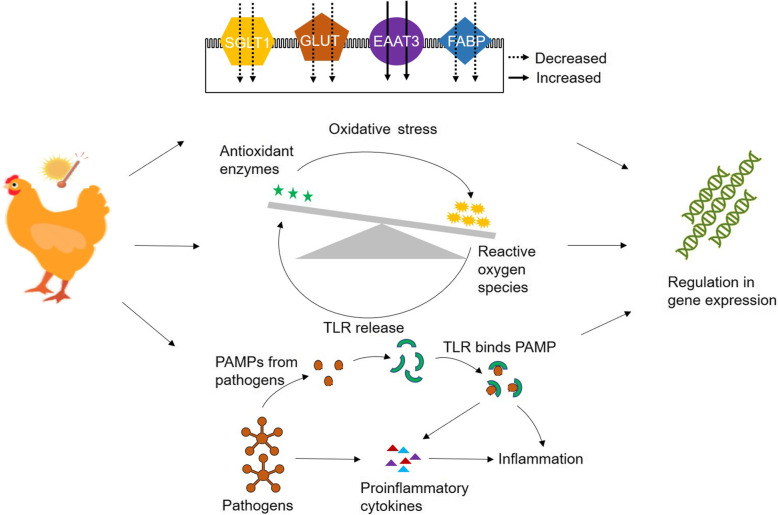- Record: found
- Abstract: found
- Article: found
Regulation of gene expression in chickens by heat stress

Read this article at
Abstract
Abstract
High ambient temperatures are a critical challenge in the poultry industry which is a key producer of the animal-based food. To evaluate heat stress levels, various parameters have been used, including growth rates, blood metabolites, and hormones. The most recent advances have explored expression profiling of genes that may play vital roles under stress. A high ambient temperature adversely affects nutrient uptake and is known to modulate the expression of genes encoding for sodium-dependent glucose transporters, glucose transporters, excitatory amino acid transporters, and fatty acid-binding proteins which are responsible for the absorption of macronutrients in the intestine. Various defensive activities are stimulated to protect the cell of different tissues from the heat-generated stress, including expression of early stress response genes coding for heat shock protein (HSP), c-FOS like protein, brain-derived neurotrophic factor (BDNF), and neuronal nitric oxide synthase (nNOS); antioxidant enzyme genes such as superoxide dismutase (SOD), catalase (CAT), and nicotinamide adenine dinucleotide phosphate oxidase (NOX4); and immune-related genes such as cytokines and toll-like receptors (TLRs). The potential role of HSPs in protecting the cell from stress and their presence in several tissues make them suitable markers to be evaluated under heat stress. BDNF and c-FOS genes expressed in the hypothalamus help cells to adapt to an adverse environment. Heat causes damage to the cell by generating reactive oxygen species (ROS). The NOX4 gene is the inducer of ROS under heat stress, which is in turns controlled by antioxidant enzymes such as SOD and CAT. TLRs are responsible for protecting against pathogenic attacks arising from enhanced membrane permeability, and cytokines help in controlling the pathogen and maintaining homeostasis. Thus, the evaluation of nutrient transporters and defense mechanisms using the latest molecular biology tools has made it possible to shed light on the complex cellular mechanism of heat-stressed chickens. As the impacts of heat stress on the above-mentioned aspects are beyond the extent to which the reduced growth performance could be explained, heat stress has more specific effects on the regulation of these genes than previously thought.
Graphical abstract
Effect of heat exposure on the nutrient transporters, antioxidants, and immune inflammation in chickens. Most of the nutrient transporters were suppressed under heat stress. Increase in the production of reactive oxygen species resulted in enhanced production of antioxidant enzymes. Expression of various proinflammatory cytokines and toll-like receptors were enhanced due to heat stress in chicken.

Related collections
Most cited references86
- Record: found
- Abstract: not found
- Article: not found
Reactive species and antioxidants. Redox biology is a fundamental theme of aerobic life.
- Record: found
- Abstract: not found
- Article: not found
Heat stress impairs performance parameters, induces intestinal injury, and decreases macrophage activity in broiler chickens.
- Record: found
- Abstract: found
- Article: not found